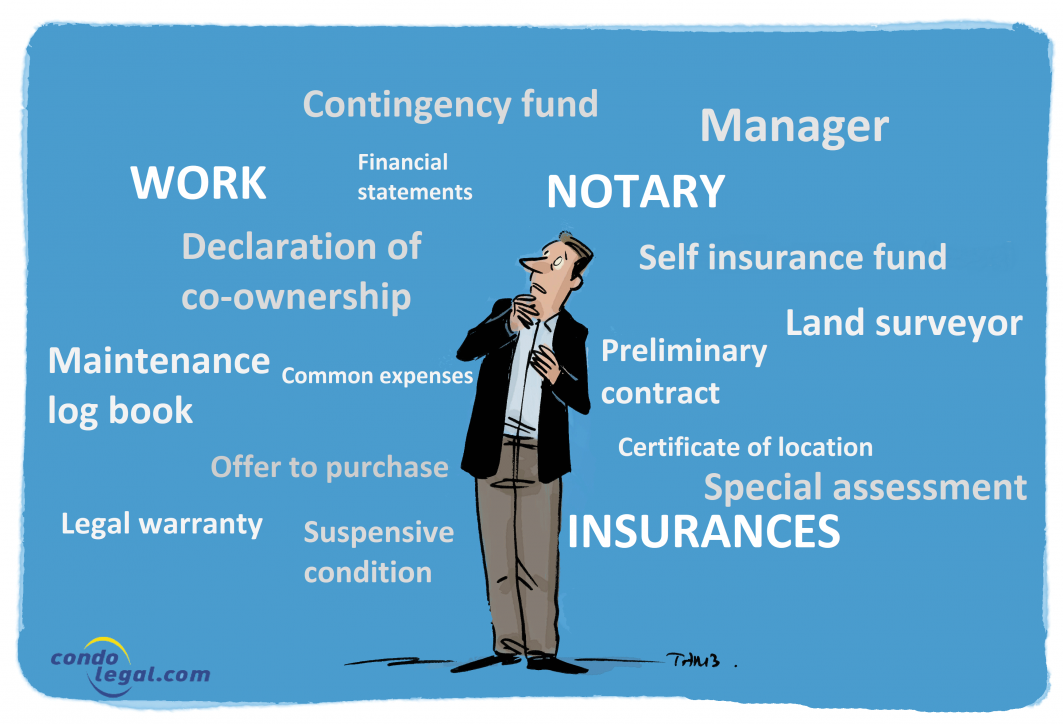 Article 1071 of the Civil Code of Québec states :" The syndicate establishes, according to the estimated cost of major repairs and the cost of replacement of common portions, a contingency fund to be used exclusively for such repairs and replacement. The fund must be partly liquid and be available at short notice, and its capital must be guaranteed. The syndicate is the owner of the fund, and the fund’s use is determined by the board of directors.». Each Syndicate is therefore required to provide sums in anticipation of these major repairs and replacement of the common portions.
Article 1071 of the Civil Code of Québec states :" The syndicate establishes, according to the estimated cost of major repairs and the cost of replacement of common portions, a contingency fund to be used exclusively for such repairs and replacement. The fund must be partly liquid and be available at short notice, and its capital must be guaranteed. The syndicate is the owner of the fund, and the fund’s use is determined by the board of directors.». Each Syndicate is therefore required to provide sums in anticipation of these major repairs and replacement of the common portions.
To ensure sufficient financial support for the contingency fund, the board of directors should establish such a fund on the basis of the recommendations of a contingency fund study, taking into account the evolution of the co-ownership, including the amounts available there.
Setting up a sufficient Contingency Fund
Although the law currently requires that the contingency fund be funded by a financial contribution from the co-owners, which cannot be less than 5% of their contribution to the common expenses, the amounts of money paid are historically very often lower than the real financial needs of the co-ownership. The downside of this under-contribution to the fund is that on many occasions, several co-owners have found themselves financially caught off guard because of special assessments imposed by the Syndicate for the realization of major work in their co-ownership.
To address this issue, article 1071 of the Civil Code of Québec was amended by Bill 16, adopted in December 2019, and Bill 31, sanctioned by the National Assembly of Québec on February 21, 2024. Article 1071 includes a new paragraph that stipulates: " The board of directors obtains a study of the contingency fund establishing the necessary amounts so that this fund is sufficient to cover the estimated cost of major repairs and replacement of common parts. This study is carried out in accordance with standards established by a government regulation, which specifically designates the professional orders whose members are authorized to conduct these studies and determines how frequently a new study must be obtained by the board of directors. These standards may vary depending on the characteristics of a building».
It is therefore a regulation of the Government that will determine the form, content and manner of holding and reviewing this contingency fund study and the persons authorized to establish it. It is anticipated that these amendments to clause 1071 of the Civil code of Quebec resulting from Bill 16 will come into force as follows:
Although these amendments to section 1071 of the Civil code of Quebec are not yet in force, it is in the interest of any syndicate to immediately implement such a management tool. Remember that the word "foresight" reflects notions of forecasting, calculations and prudence.
Role of the professional
To establish an adequate contingency fund, the board of directors must have the cost of major repairs and replacement of common portions estimated by a competent professional. The Contingency fund study is intended to be the tool to accomplish this budgetary exercise essential to the sound management of a building held in co-ownership.
This study makes it possible to develop a contingency fund financing strategy that is intended to be fair to all co-owners, current and future, by avoiding one-off charge calls that only affect the co-owners in place at that time, while targeting the needs deemed necessary, without underfunding or undue surplus. The horizon of analysis of such a study should extend over a sufficient period to cover all major repairs and replacement of common portions. Experts normally consider a 25-year horizon, with a provision to finance major interventions that are expected to occur after the period under review. A shorter horizon could distort the data, as it would possibly exclude certain components of the calculation, such as roofs and windows.
Methodology underlying the study
The study of the contingency fund has a physical dimension and a financial dimension. The condition and foreseeable life of the various components of the building must first be assessed and then the costs of repair and replacement must be estimated.
Specifically, the physical dimension typically involves the following steps:
As for the financial dimension, it usually involves the following steps:
In the end, a report will be produced that includes:
Who can carry out this study?
The study of the contingency fund is a complex exercise that requires actuarial and technical skills. For the moment, the law does not specify who is the professional qualified to carry it out, and what is the methodology to be followed. However, these details will eventually be known by a government regulation that will designate, in particular, the professional orders whose members are authorized to carry out these studies.
For the time being, the Regroupement des gestionnaires et copropriétaires du Québec (RGCQ) has set out parameters that led to the creation of a Standardized Contingency Fund Study. It has also implemented a certification system available to building professionals. In short, the RGCQ has created a standard of practice to ensure a better protection of the syndicates of co-ownership built up heritage.
Features of the contingency fund study
In principle, this study should focus on interventions that are likely to occur within a limited time horizon, a delicate subject to define in temporal terms. According to the amendments made to Article 1071 of the Civil Code of Québec by Bills 16 and 31, the board of directors must obtain a study of the contingency fund establishing the necessary amounts to ensure that this fund is sufficient to cover the estimated cost of major repairs and replacement of common areas. This study is conducted in accordance with standards established by a government regulation, which notably designates the professional orders whose members are authorized to conduct these studies and determines how frequently a new study must be obtained by the board of directors. These standards may vary depending on the characteristics of a building. To find a fair balance, the author Christine Gagnon advocates introducing the following clause into the declaration of co-ownership (the constitutive act of co-ownership):
The board of directors must ensure, before awarding a service contract to a professional to conduct this study, that it will cover a reasonable period. It is specified that a period exceeding forty (40) years from the date of the study is unreasonable, unless otherwise provided by law at that time, if applicable. Thus, with this reservation, the study should cover at most a period of twenty-five (25) or thirty (30) years from the date of the study, unless exceptional circumstances that the board of directors will need to explain and justify, while keeping the study over a reasonable period. To assess the reasonableness of the period, one must take into account the fact that the study will be periodically reviewed as stipulated below. One must also consider the reliability of a forecast of a situation too far in the future, for example, the very existence of the co-ownership or the building in its current state at that time, the possibility of available subsidies for certain works, the nature of the materials that will be used at the end of the period, the construction techniques that will be available when the works are carried out, etc.
The declaration should also specify that the board of directors must ensure, when requiring an update of the contingency fund study, that the revision or new study covers a reasonable period as stipulated above.
 WHAT YOU SHOULD KNOW! Nowadays, prospective condo purchasers are more and more concerned about the deficient management of several immovables. Many of them will want to know if the amounts in the Contingency Fund are sufficient. In this regard, article 1068.2 of the Civil Code of Quebec requires the syndicate to provide the promising buyer with the documents or information enabling the latter to make an informed choice.
WHAT YOU SHOULD KNOW! Nowadays, prospective condo purchasers are more and more concerned about the deficient management of several immovables. Many of them will want to know if the amounts in the Contingency Fund are sufficient. In this regard, article 1068.2 of the Civil Code of Quebec requires the syndicate to provide the promising buyer with the documents or information enabling the latter to make an informed choice.
 WHAT TO KEEP IN MIND: The “Contingency Fund" concept is based on an equity principle between the successive co-owners of the building. Amounts are gradually accumulated in the short, medium and long term, based on an estimate of costs related to the foreseeable life expectancy of some components of the immovable. All co-owners must contribute to this fund, in accordance with the user-payer approach, as long as they own it.
WHAT TO KEEP IN MIND: The “Contingency Fund" concept is based on an equity principle between the successive co-owners of the building. Amounts are gradually accumulated in the short, medium and long term, based on an estimate of costs related to the foreseeable life expectancy of some components of the immovable. All co-owners must contribute to this fund, in accordance with the user-payer approach, as long as they own it.
 WARNING! At least four out of ten syndicates of co-owners state, based on surveys, that they do not have enough money to finance this work. This number increases considerably in immovable built before the year 2000. To alleviate this situation, syndicates caught unprepared use special assessments.
WARNING! At least four out of ten syndicates of co-owners state, based on surveys, that they do not have enough money to finance this work. This number increases considerably in immovable built before the year 2000. To alleviate this situation, syndicates caught unprepared use special assessments.



